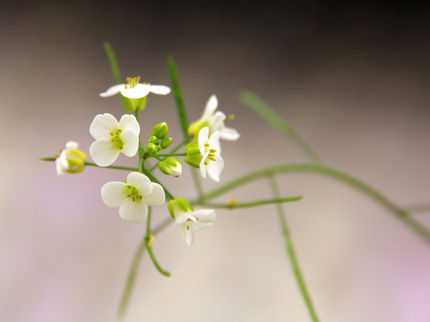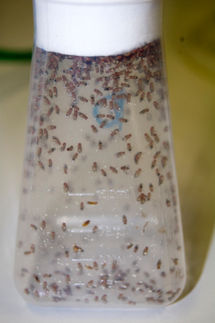Looking for love in all the right places: Fruit odors lure some flies to evolve into new species, Cornell researchers discover
GENEVA, N.Y. - For apple maggots, the dating scene is simple - flies only mate on a specific host fruit. Using new technology developed at the New York State Agricultural Experiment Station, Cornell University researchers have demonstrated that this fact of fly life has resulted in the emergence of two distinct races of the pest in just 150 years.
In research published in the Online Early Edition of the Proceedings of the National Academy of Sciences Web site Sept. 22, the scientists show that one mechanism by which these flies find their host plant is a preference for specific blends of fruit odors. The preference is both strong enough and sensitive enough that the two races of maggot no longer interbreed, the first step in the evolution of a new species. The discovery, the researchers say, opens up a possible new area of organic pest control.
The researchers at the Geneva Experiment Station, part of the College of Agriculture and Life Sciences at Cornell, Ithaca, N.Y., are Charles Linn, Satoshi Nojima and Wendell Roelofs. Their collaborators are Jeffrey Feder from the University of Notre Dame and Stewart Berlocher from the University of Illinois.
Evolutionary biologists theorize that two populations of a species must be isolated from each other if they are to develop into two distinct species, and Darwin provided the example of one species of bird diverging and becoming reproductively isolated on separate islands in the Galapagos. Recently it has been proposed that the separation need not be geographic or even physical. A shift in the use of a new host plant for mating and the laying of eggs could be enough to keep insects that occupy the same area at the same time from mating. This process is termed "sympatric speciation," and that is what the researchers believe has happened with hawthorn maggots.
The apple and hawthorn maggots are common names for the same species, Rhagoletis pomonella. The pest and the hawthorn plant are native to North America, but the apples they now infest were introduced from Europe around 250 years ago. During the 1860s, in New York's Champlain Valley, some hawthorn flies shifted to apple plants as their host, while others did not."There are no morphological differences between the two, so they are still the same species, but two races can be distinguished by looking at the diversity of protein structures of whole populations and by the specificity of individual flies to different host plants," explained Roelofs, who is the Liberty Hyde Bailey Professor of Insect Biochemistry at Cornell.
R. pomonella has been studied for many years, but it was only with the development by postdoctoral researcher Nojima of sophisticated laboratory techniques to select the key components of fruit odors that the behavior of the insects could be rigorously tested.
Using a process called solid phase microextraction, volatiles were absorbed from the fruit and identified in a gas chromatograph using a live insect's own antennae as part of the detection process to determine which volatiles the flies use for host-plant identification. Once key compounds were identified, Linn ran behavioral tests in a flight tunnel. Blends of the apple and hawthorn volatiles identified in the lab were synthesized and then tested for insect behavior. If the insect recognized the test odor, it oriented itself toward the source and flew upwind to reach it. The scientists found that almost exclusively apple maggots only responded to apple odors, and hawthorn maggots only responded to hawthorn odors.
Behavioral tests also were conducted in the field. Traps were baited with one of the two blends and placed in hawthorn stands and apple orchards. Just as in the lab, the flies of one race largely ignored, or even avoided, the chemical scent of the other race's fruit.
"The results in the field are really very strong," said Linn. "It adds a level of validation that we also saw the same pattern in field trials in Michigan and Indiana."
In addition to the impact on ecology and evolutionary biology, the research has several applications. Other scientists at Cornell already are using the blends developed in this research to monitor populations of hawthorn and apple maggots in orchards and fields across New York state.
The team also identified several components of hawthorn and flowering dogwood -- a third member of the R. pomonella species complex. These blends are not simply ignored; some actually deter apple maggots. Roelofs' lab has begun field trials to see if introducing the dogwood and hawthorn odor, or components of it, into apple orchards or around the fruit itself could provide a means of organic pest control against the apple maggot.
The research was funded by a $1.6 million grant from the National Science Foundation.
See the theme worlds for related content
Topic world Gas chromatography
Gas chromatography is an essential method in analytical chemistry for the separation and analysis of volatile compounds. Due to its high resolution and sensitivity, it has become firmly established in areas such as environmental analysis, food chemistry or forensic science. GC provides precise and reliable results and enables deep insights into the chemical composition of samples.

Topic world Gas chromatography
Gas chromatography is an essential method in analytical chemistry for the separation and analysis of volatile compounds. Due to its high resolution and sensitivity, it has become firmly established in areas such as environmental analysis, food chemistry or forensic science. GC provides precise and reliable results and enables deep insights into the chemical composition of samples.




















































